A VVS diamond (Very Very Slightly included) and a VS diamond (Very Slightly included) differ in clarity and, if all else is equal, they can differ significantly in price. Knowing these differences can help you make a smart engagement ring purchase.
In this blog, we cover:
VVS Diamond versus VS Diamond: Why you need to know the difference
Diamond clarity: Blemishes and inclusions
How GIA determines clarity grades for diamonds
What are VVS diamonds?
What are VS diamonds?
So, which should you choose – a VVS diamond or a VS diamond?
Get a GIA Diamond Grading Report for an accurate and unbiased clarity grade
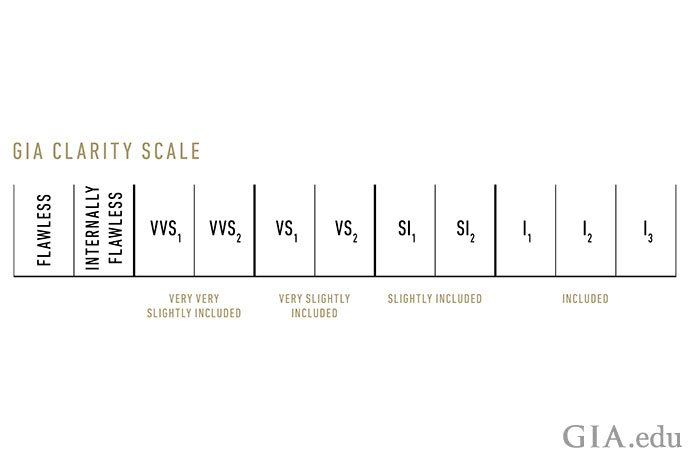
The GIA Clarity Scale contains 11 possible clarity grades.
VVS Diamond versus VS Diamond: Why you need to know the difference
If you’ve been comparing diamonds for an engagement ring purchase, you’re no doubt already aware of the GIA 4Cs of diamond quality: Color, Clarity, Cut and Carat Weight. You’ve noticed that diamond quality and size affect price. That’s because larger diamonds that are graded high on the color, clarity and cut scales are rarer, so they cost more. But in comparing diamonds of equal size, you may have also discovered that even the smallest differences in grades – quite often impossible to detect with the naked eye – can have a significant impact on price.
In this blog, we’ll focus on diamond clarity grades – specifically, on two grading categories that seem to generate a lot of questions and discussion online: VVS (Very Very Slightly included) and VS (Very Slightly included). There are two subcategories within each of these (VVS1, VVS2 and VS1, VS2). They represent how easily the defining clarity characteristics can be seen when the diamond is examined face-up under 10× magnification. In almost all cases, the clarity features in both VVS diamonds and VS diamonds cannot be seen with the naked eye. Yet, price differences between these two diamonds can be as high as 40%. For example, according to a 2023 diamond pricing sheet used by most wholesalers and retailers, a 1.00 carat (ct), D color, VVS1 diamond can be 40% more expensive than a VS1 diamond of the same weight and color. A 1.00 ct G-H color, VVS1 diamond can be 15%–20% more expensive than a comparable VS1 or VS2 diamond.
If you’re buying a diamond of this quality, the difference in price can be significant. That’s why it pays to learn about what determines the difference in clarity between a VVS diamond and a VS diamond—so you know which clarity grade is best for your purposes and budget.
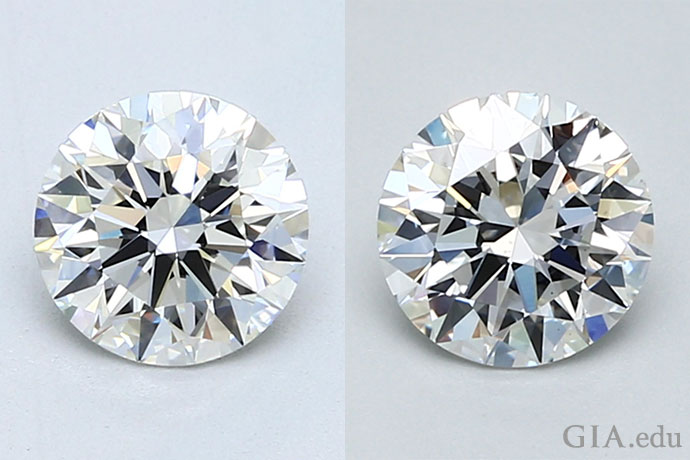
Can you tell the difference between these two 1.00 ct, G color, Excellent cut round brilliant diamonds? The diamond on the left has a clarity grade of VVS1 and costs 15% more than the VS2 diamond on the right. Courtesy: Blue Nile
Diamond clarity: blemishes and inclusions
Diamond clarity refers to a diamond’s internal and external features. These can exist due to a diamond’s formation process or through cutting, polishing and daily wear. Some call these features “marks” or “flaws,” but the correct term is “clarity characteristics.” These characteristics contribute to each diamond’s unique identity.
There are two types of clarity characteristics: blemishes and inclusions. A blemish is an external feature on the surface of a diamond. Examples would be polish lines, abrasions on facet junctions, and extra facets.
An inclusion is an internal feature that is either totally enclosed within a diamond or extends into the gem from its surface. Common inclusions include feathers (fractures or fissures), crystals, pinpoints, clouds (groups of pinpoints), internal graining, and needles. For photos and detailed descriptions of these and other clarity features, check out our blogs on blemishes and inclusions.
Blemishes usually only affect the clarity grade in the top two categories (Flawless and Internally Flawless), whereas inclusions affect all grades. For VVS and VS diamonds, we’ll focus on inclusions only.
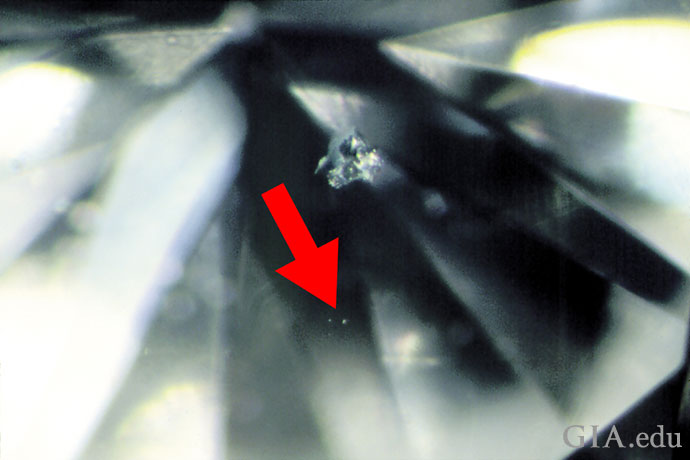
A pinpoint is a tiny crystal inclusion that looks like a dot at 10× magnification. This diamond contains a few pinpoints with a larger crystal inclusion above them. Photo: John I. Koivula/GIA. Courtesy: K.R. Gems & Diamonds International
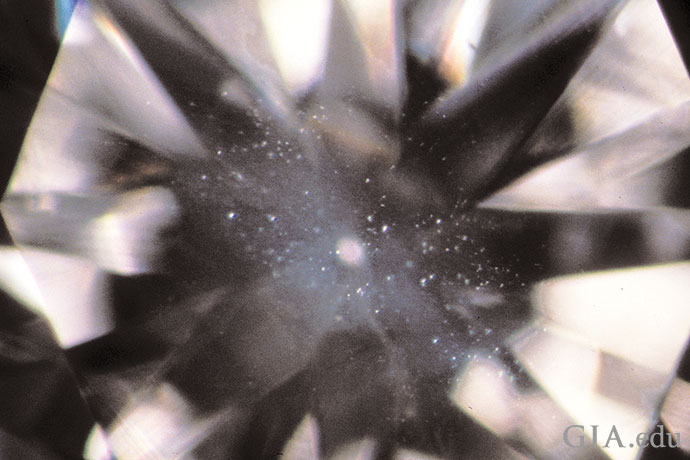
Clouds are groups of pinpoints that might be too small to distinguish individually but have a hazy appearance seen together. Photo: John I. Koivula/GIA
Diamonds with few or no clarity characteristics are very rare. So, all else being equal, diamonds with fewer inclusions – or smaller, less noticeable inclusions – are usually more expensive than diamonds with more inclusions – or larger, more obvious ones. That’s why, all else being equal, VVS diamonds will cost more than VS diamonds.
VVS diamonds have less obvious inclusions than VS diamonds. To know how this impacts your diamond, let’s take a look at how GIA grades diamond clarity and what the different subcategories of VVS and VS represent.
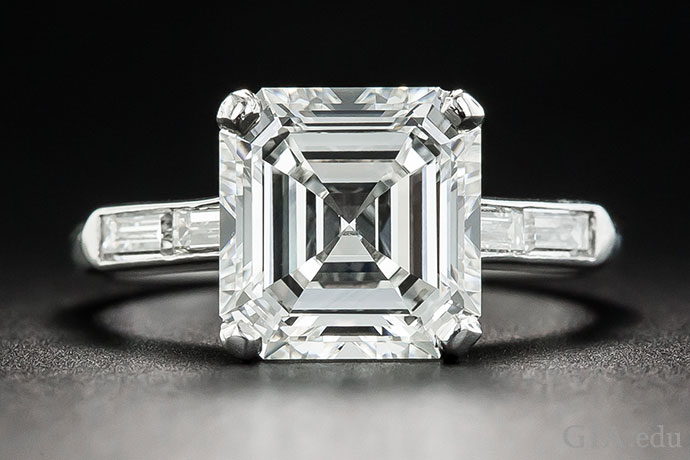
A visible inclusion would mar the beauty of this 3.30 ct. Asscher cut, H color, VVS1 clarity diamond. Courtesy: LangAntiques.com
How GIA determines clarity grades for diamonds
In the GIA clarity grading system, 10× is the standard magnification used to determine a diamond’s clarity grade. While GIA diamond graders use their trained eye and a microscope at increased magnification to examine a diamond, they make the final grading call based on what they can see using a standard 10× jeweler’s loupe.
In arriving at a clarity grade, the grader takes into account five factors:
- Size: When all other factors are equal, the larger the inclusion or blemish is relative to the size of the diamond – and, therefore, the more visible it is – the lower the diamond’s clarity grade will be.
- Number: When all other factors are equal, the more inclusions, reflections of inclusions, or blemishes that are visible face-up at 10× magnification, the lower the diamond’s clarity grade will be.
- Location: This refers to the position of an inclusion or blemish. The closer an inclusion is to the center of the table (large facet face-up in the middle of the diamond), the greater effect it will have on the clarity grade.
- Relief: This refers to the contrast between the inclusion or blemish and the diamond. Generally, the more the clarity feature differs in brightness, darkness or color from the diamond, the more visible it is and the greater its impact on the clarity grade.
- Nature: Here the grader looks at the nature or the type of characteristic and what effect it has on the appearance of the diamond. Some inclusions or blemishes, such as chips or feathers, can have greater impact on the clarity grade than others.
After the GIA grader has identified the diamond’s clarity characteristics and taken into consideration the five factors listed above, he or she assigns a clarity grade based on the following criteria:
| Clarity Grade | Visibility at 10× Magnification |
| Flawless (FL) | No inclusions and no blemishes visible at 10× magnification |
| Internally Flawless (IF) | No inclusions and only insignificant blemishes visible at 10× magnification |
| Very Very Slightly included (VVS1 and VVS2) | Minute inclusions that range from extremely difficult (VVS1) to very difficult (VVS2) to see at 10× magnification |
| Very Slightly included (VS1 and VS2 ) | Minor inclusions that range from difficult (VS1) to somewhat easy (VS2) to see at 10× magnification |
| Slightly Included (SI1 and SI2) | Noticeable inclusions that are easy (SI1) or very easy (SI2) to see at 10× magnification but usually are not eye visible |
| Included (I1, I2 and I3) | Obvious inclusions visible at 10× magnification – and often seen with the unaided eye |
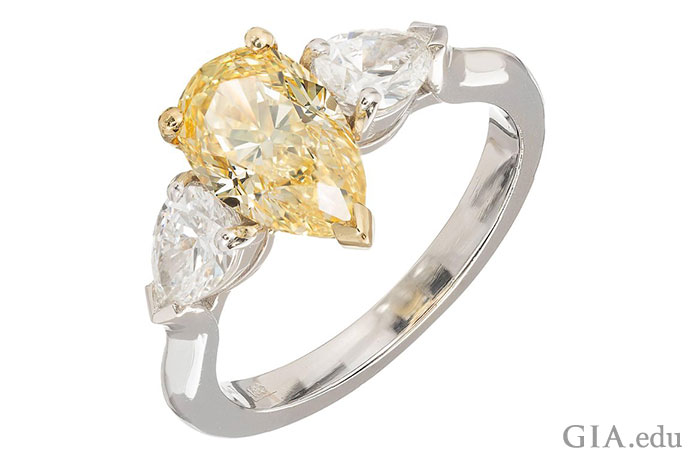
All three pear-shaped diamonds in this ring have VVS2 clarity. The center stone is a 1.54 ct. Fancy Intense yellow diamond. Courtesy: 1stdibs.com
What is a VVS diamond?
As indicated in the above clarity grade chart, a VVS diamond contains minute inclusions that range from extremely difficult (VVS1) to very difficult (VVS2) to see at 10× magnification. Typical inclusions that might set the VVS grade include:
- Pinpoints, needles, internal graining or clouds that are visible only through the pavilion (the bottom half of a diamond that is below the girdle) or are extremely difficult to see face-up at 10× magnification (VVS1)
- Pinpoints, needles, internal graining or clouds that are very difficult to see face-up at 10× magnification (VVS2)
- Minute surface-reaching inclusions (chip, cavity, feather, bruise, bearding, indented natural, etc.)
A diamond with eye-visible inclusions would not receive a clarity grade of VVS1 or VVS2.

Internal graining is a type of inclusion caused by irregularities during crystal growth that can appear as lines, angles or curves. For this diamond, the nature of the inclusion and its location in the diamond’s pavilion contributed to a clarity grade of VVS1. Had the same inclusion been located under the diamond’s table, the diamond might have received a lower clarity grade. Photo: Shane F. McClure/GIA

This diamond has a clarity grade of VVS2. The red box surrounds a tiny feather that is very difficult to see face-up at 10× magnification. A feather results from a break along one of the diamond’s four octahedral planes. Feathers can appear white or transparent. In this example, the feather will likely be hidden by a prong when the diamond is set. Photo: GIA
What is a VS diamond?
A VS diamond contains minor inclusions that range from difficult (VS1) to somewhat easy (VS2) to see at 10× magnification. Many different types of inclusions are possible, but they must be very small relative to the size of the diamond. Typical inclusions that might set the grade include some crystals, knots or distinct clouds, or minor surface-reaching features such as a feather or a cavity. In very rare cases, a large VS stone might contain an eye-visible inclusion.

Gazing into an emerald cut diamond should be like gazing into a clear icy pool. That’s why emerald cuts look best with gems of higher clarity – like the VS1 clarity, F color, 5.48 ct. center stone in this platinum ring, which also features two shield cut side stones and a halo of colorless diamonds. Courtesy: Raiman Rocks, Inc.

This diamond has a clarity grade of VS1. The red box surrounds a small feather that is difficult to see face-up at 10× magnification. Unlike the VVS2 example shown above, however, it is under the table of the diamond and cannot be hidden by the setting. Photo: GIA

This diamond has a clarity grade of VS2. The red box surrounds a feather that is close to the table and easy to see when the stone is examined face-up at 10× magnification. Photo: GIA
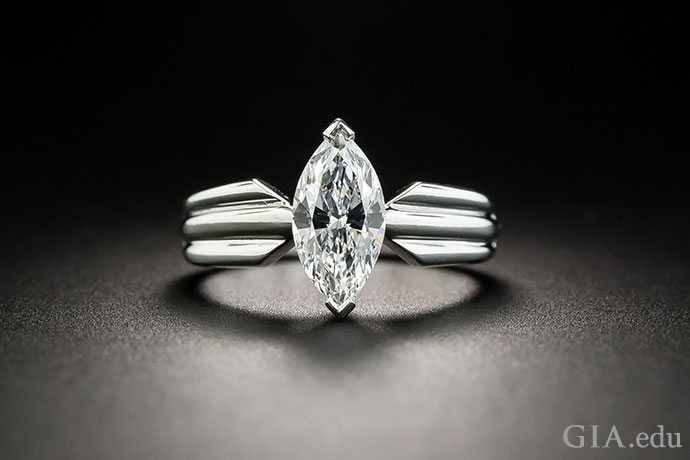
A VVS2 marquise cut diamond commands the stage in this Cartier engagement ring. Courtesy: LangAntiques.com
So, which should you choose – a VVS diamond or a VS diamond?
Now that you know the technical differences between a VVS diamond and a VS clarity diamond, you may ask yourself: is a higher clarity grade worth the expense? On one hand, in almost all cases, VS clarity stones will not have eye-visible inclusions, making them virtually indistinguishable from VVS diamonds to the unaided eye. On the other hand, VVS2 clarity diamonds are closer to perfect – and rarer – than lower-clarity stones.
For some, the decision might be driven by the cut and shape of the diamond. Step-cut diamonds featuring large rectangular facets, like emerald cuts, look best at higher clarity grades, as do some brilliant cuts like heart and marquise. For others, the decision may be purely symbolic.
However, selecting the most suitable diamond doesn’t depend on clarity alone. It involves choices between clarity, cut, color and carat weight. If budget is a consideration – and it is for most engagement ring buyers – the price you save with a VS clarity diamond might allow you to purchase a larger diamond or one with better color or cut.
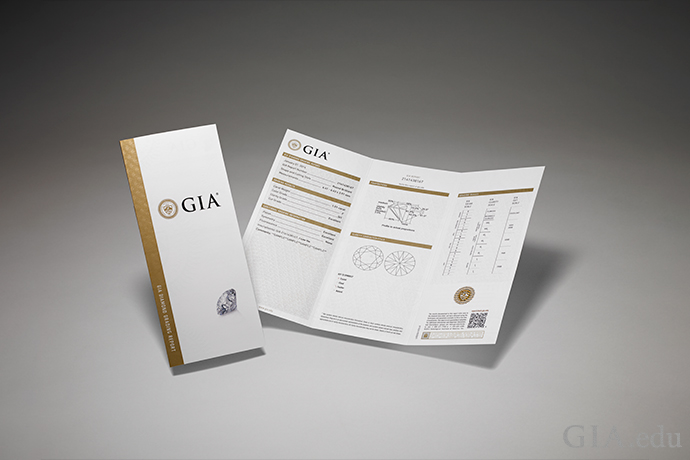
A GIA Diamond Grading Report gives you the information you need to buy a diamond with confidence.
Get a GIA Diamond Grading Report for an accurate and unbiased clarity grade
Regardless of which clarity grade you choose, you’ll want to make sure the diamond was graded by GIA. This will ensure that its clarity assessment – along with its color, cut and carat weight – is accurate and objective, and adheres to the exacting 4Cs grading standards that GIA developed.

The small crystals under this diamond’s table make this diamond fall under a VS1 grade. Illustration: GIA
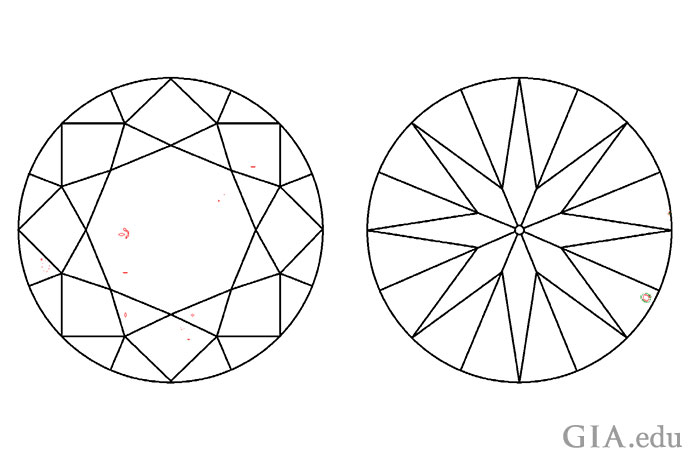
This clarity plot of a VS2 diamond shows the grade-setting inclusions: a few crystals under the table, and a cavity on the pavilion. Illustration: GIA
A GIA Diamond Grading Report not only contains the diamond’s clarity grade, but it also provides a plotted diagram. The diagram maps the inclusions and/or blemishes observed at 10× magnification on the table and pavilion, showing you their approximate shape and location on the diamond. The diagram serves to document the diamond’s condition at the time it was graded and supports the diamond’s clarity grade. And, because no two diamonds will have the same plotted diagram (unless they are both Flawless), it serves as a means of identification.
Learn how to read a GIA plotted diagram.
Picking out an engagement ring often means making a series of decisions concerning cost, quality and style. Knowing the 4Cs and other quality factors can help you pick out a ring that best suits you and your loved one’s taste and budget.
Ready to consider diamond shapes? Here’s a post that will walk you through each one.
